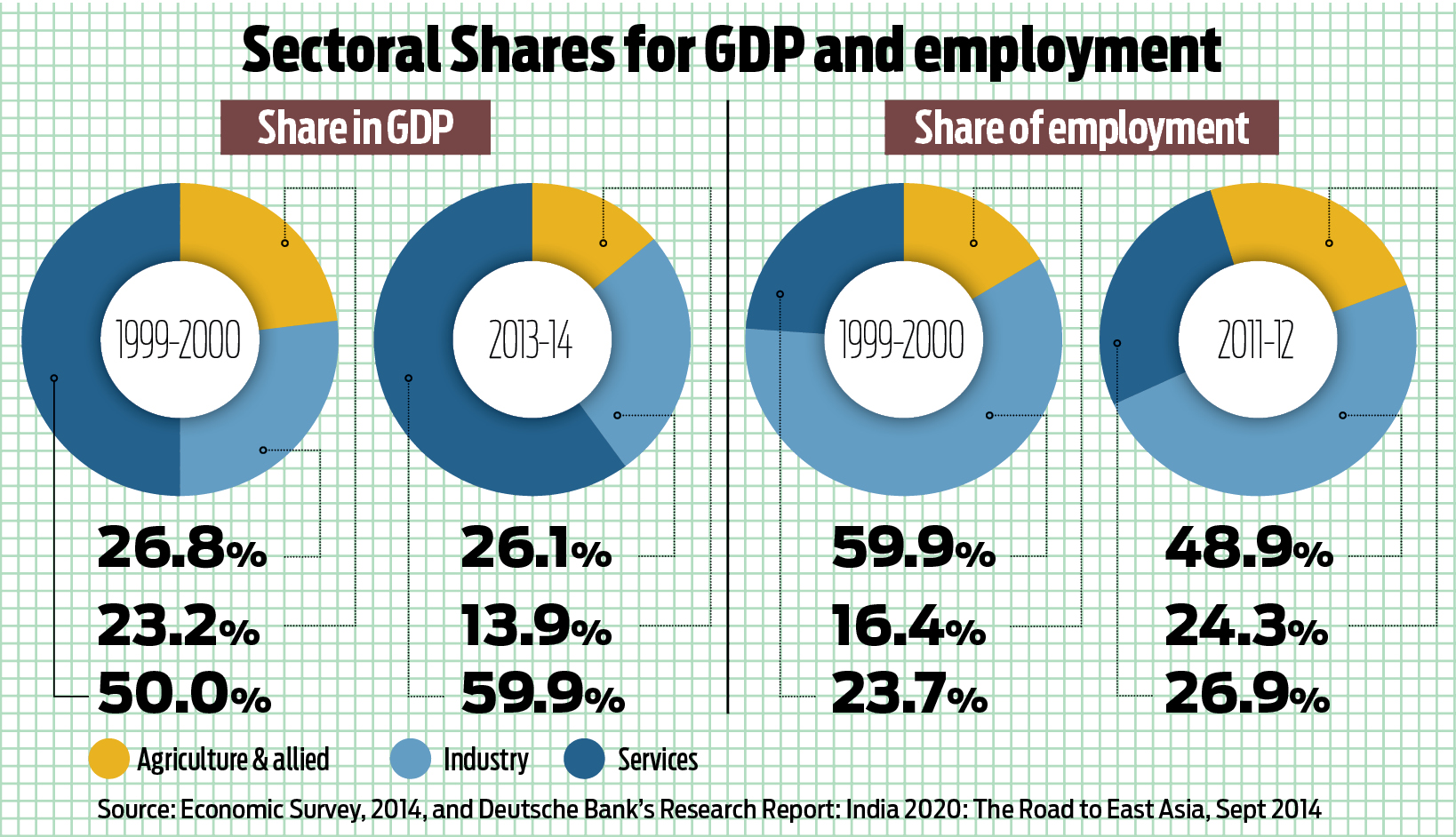
It is finally happening. It has been something that India’s industrialists have been crying themselves hoarse about. That the country needs more manufacturing quickly. Because manufacturing creates more jobs than do services.
Some economists disagree. They insist that services will drive the wheels of India’s economy in the future. That services create direct as well as indirect employment. For instance, a software centre will need vehicles to ply people back and forth from their homes to their offices. Similarly, they will need someone to set up small restaurants or coffee-shops where they could have a snack or two. The list could be long.
But manufacturing does this as well. This sector also promotes transport and eateries. However, unlike services, manufacturing requires a broader range of skills — from grunt workers, packers and forwarders to plumbers, fitters and electricians... the list is longer. And the numbers larger.
Manufacturing makes jobs
This is borne out by numbers (see table). While the share of services in India’s GDP has gone up from 50% to 59% over the last 15 years, its share of total employment is contribution to employment has gone up marginally — from under 24% to under 27% during a 12-year period. In other words, a 10% increase in share of GDP has accounted for just a 3% increase in employment.

On the contrary, even though the share of industry in India’s GDP went down marginally during this 15-year period (from 26.8% to 26.1%), its share of total employment went up from 16.4% to 24.3% (during 12 years). In fact, economists like Arvind Panagariya have been saying this for quite some time. In April 2011, he pointed out how, “the last available statistics show that 38% of India’s output came from the top 650 service enterprises (like TCS, Infosys and Wipro). But they account for just 2% of employment.”
Yet manufacturing — which could have employed more people — had opted to become capital intensive, primarily because it wanted to avoid many of the cumbersome labour laws in India. “This,” said Panagariya, “could pose a major problem for India’s growth because India’s share in the world market is just 1% primarily because high labour costs [and related encumbrances] have been edging out industry from export competitiveness. China’s labour costs have begun to rise. Many of its labour-intensive industries are closing down. This is an opportunity for India, but only if its labour laws are made more flexible.”
That could explain why the Modi government was quick to flag off labour reforms. But the going can be tough. Many opposition parties like the Congress and the Left are eager to trip up the government by inciting workers to go on a strike if labour laws are relaxed. Some political parties have already tried instigating unions in banks and the railways to go on strike because of foreign direct investment (FDI) inflow relaxation. Remember, these two segments are very large employers in the country. Luckily, India’s workforce also comprises parents — who desperately want their children to get jobs. And, intuitively, they know that unless some conditions get relaxed, India may not be able to find easy and quick employment for its teeming millions.
That could explain Modi’s renewed pursuit of the “Make in India” vision. He knows that India needs to generate fresh employment for at least 10 million (of its 20 million) youth entering the job market each year. The focus, therefore, will be on manufacturing.
First infrastructure, then factories
But manufacturing needs infrastructure — power, roads, and free movement of goods across states. That also explains Modi’s focus on infrastructure and FDI. The good thing about infrastructure development — especially roads, rails and bridges — is that they can create fresh employment overnight.
But building infrastructure costs money. That partly explains the renewed push Modi’s government has given to the completion of the (FDI-aided) dedicated freight corridor (DFC), industrial corridors like the DMIC (Delhi-Mumbai-Industrial-Corridor), and smart cities to take care of the large scale migration of people from rural to urban areas that is bound to take place within the next two decades. Expect Modi’s government to roll out the red carpet for further investments in similar projects. Watch how Singapore and Japan have got together to build a smart city on 2,500 acres of land near Chennai. Expect many more such FDI-funded projects springing up, spanning roads, railroads, industrial complexes, affordable housing and, most importantly, better designed and planned cities.
The good part is that infrastructure building creates the first round of immediate employment, boosts overall purchasing power, and just when the economy is on the rebound, manufacturing can piggyback on this improved infrastructure.
Three conditions need to be met
First, the selling of goods within India (like tourism within the country) needs to be made cheaper and easier than it currently is. That makes the introduction of GST (Goods and Services Tax, collected at one point rather than at each state border) and the abolition of APMCs (Agricultural Produce Marketing Commissions, which prevent farmers from finding their own markets) extremely critical.
Second, existing labour laws that frighten people away from large scale manufacturing need to be modified. Rajasthan has shown how this can be done. This needs to be followed by other states as well.
Third, manufacturing needs to employ the best talent. Currently, the best talent goes to the financial services sector. That’s because the finance sector offers better pay packages and incentives (read bonuses) than manufacturing has ever provided. This needs to change. Germany, China, Singapore and Korea are good examples of how this can be done. India needs to study them and find its own ways. But more on this later.
And, most importantly, India’s manpower needs to be upgraded with better school education. India’s school education standards have collapsed. No amount of good college education can undo the wrongs bad school education can unleash on a growing child. But more on that too later.
The author is a consulting editor with dna